This article was gladly contributed by author P.A. Glaspy.
Since moving to the country and working toward self-sufficiency, I find myself paying a lot more attention to what’s coming out of the ground. I walk around taking pictures of plants on my phone, so I can look them up online and find out what they are and, more importantly, what use they may have, either nutritionally or medicinally – or both. Plants I had always thought were weeds or just wildflowers I have since found actually have wonderful medicinal uses. Sadly, much of this information has been lost through the generations as young people are more interested in the latest social media craze than what the old folks could teach them. Unless you still have your great-grandmother, who grew up in the mountains and was the local source for home remedies, or your great-grandfather was the medicine man of your tribe, you haven’t been taught what nature’s bounty can do for you and your family.
Years of weed killers have all but decimated beneficial plants and herbs. In the quest for the perfect lawn, society has snubbed the dandelion and the plantain, along with chickweed and clover. All four plants are edible. All four plants have medicinal uses. All four plants produce flowers which feed honey bees, a tiny animal we are very dependent on for life but are in serious danger of losing for good. And yet they are classified as weeds or nuisance plants and thus must be destroyed. When did a good looking lawn become more important than food and healing?
If you are like me and are hungry for more natural solutions as an alternative to “modern” medicine, you’ve spent a lot of time researching other options online. You may be one of the few who has found out there are a lot of beneficial plants that grow wild. But you still need to get outside and see what you have to work with in your own yard. I have found almost everything mentioned in this article growing on our place. It’s exciting to know that I have the tools needed to treat aches and pains, as well as stomach or kidney issues, right outside my door.
In my internet perusals, I have found some plants that are so similar in looks they are often mistaken for each other. I thought I’d share a few with you in the hopes we can all know what we have and what it can do while giving us something else to keep our eyes out for while walking the land. This is by no means a complete list of the beneficial aspects of these plants. I didn’t have enough room for that here. I strongly encourage anyone who may be interested to look them up. If you want to try them yourself, please check with your doctor if you are on any medications. Sometimes Mother Nature and modern medicine don’t play well together.
Mullein and Lambs Ear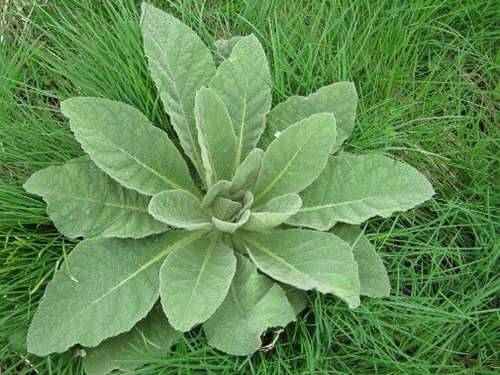
Mullein – (Verbascum thapsus) This plant can be found along the road in many places and has been used for hundreds of years for medicinal purposes. I’ve found at least four plants on our property close to the house. It is used in respiratory disorders such as asthma and tuberculosis. It is a natural expectorant and a cough suppressant. It can be ingested in teas and tinctures, as well as smoked. Because it has antiviral and astringent properties, as well as soothing effects, it can also be used as a topical treatment for things like burns, bruises, hemorrhoids, and herpes.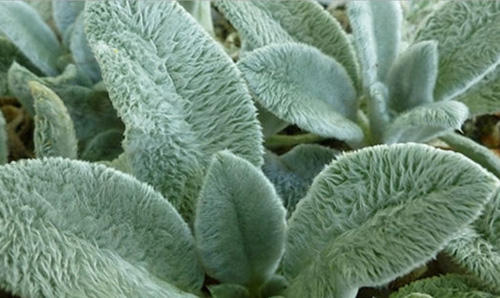 Lambs Ear – (Stachys byzantina) I planted this in a flowerbed once to use it as a border plant. I just loved the soft, fuzzy leaves. A few years later, it had taken over a third of the bed and was growing in the yard across the walk. I had no idea at the time what an amazing plant it was nor how prolific. Its leaves have been used for bandages and dressings in battlefield situations. The leaves absorb blood quickly and assist with clotting. They have antiseptic, antibacterial, and anti-inflammatory properties. It literally is nature’s bandage. It has many more uses than I can list in this article. Search the internet and prepare to be amazed. If you decide to plant some and don’t want it to take over the area, I’d suggest putting it in a container.
Lambs Ear – (Stachys byzantina) I planted this in a flowerbed once to use it as a border plant. I just loved the soft, fuzzy leaves. A few years later, it had taken over a third of the bed and was growing in the yard across the walk. I had no idea at the time what an amazing plant it was nor how prolific. Its leaves have been used for bandages and dressings in battlefield situations. The leaves absorb blood quickly and assist with clotting. They have antiseptic, antibacterial, and anti-inflammatory properties. It literally is nature’s bandage. It has many more uses than I can list in this article. Search the internet and prepare to be amazed. If you decide to plant some and don’t want it to take over the area, I’d suggest putting it in a container.
How to tell the difference: Mullein will usually be a single plant with long pointed leaves. Lambs ear is more likely to be in a bed covering the ground. Its leaves are thicker and softer. Bonus: both can be used as an alternative to toilet paper!
Related: The Only Plant That Should Be in Your First Aid Kit
Devil’s Walking Stick and Elderberry trees
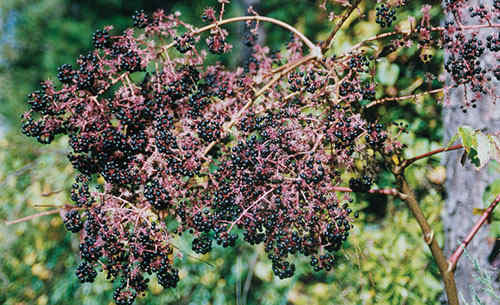
Devil’s Walking Stick – (Aralia spinosa) We found a few of these in the yard. When I first saw them, I thought they were elderberry. The blossoms (which the bees absolutely adore) and the berries are very similar. The only way I could tell them apart is that this tree has large spines on it. The roots and berries are most well-known to ease toothaches, which has garnered it the nickname the toothache tree. In a tincture applied topically they can ease the pain of arthritic joints and rheumatism.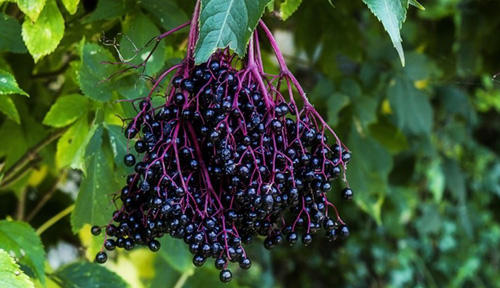 Elderberry – (Sambucus nigra) It’s hard to find anyone who hasn’t heard of this plant and the amazing health benefits it provides. With the recent harsh flu season, a combination of a prescribed medicine and elderberry syrup seemed to be the best remedy for getting well quickly. It is one of the top antivirals on the planet. It is also one of the highest in flavonoids which give it a super antioxidant power. If you start taking it at the onset of cold or flu symptoms it can reduce the duration by half or more as opposed to someone who didn’t take it. It can be used just about any way you can think as far as its application. I keep tinctures on hand all the time.
Elderberry – (Sambucus nigra) It’s hard to find anyone who hasn’t heard of this plant and the amazing health benefits it provides. With the recent harsh flu season, a combination of a prescribed medicine and elderberry syrup seemed to be the best remedy for getting well quickly. It is one of the top antivirals on the planet. It is also one of the highest in flavonoids which give it a super antioxidant power. If you start taking it at the onset of cold or flu symptoms it can reduce the duration by half or more as opposed to someone who didn’t take it. It can be used just about any way you can think as far as its application. I keep tinctures on hand all the time.
How to tell the difference: The blooms and fruit are very similar. The best way to tell at a glance is devil’s walking stick has thorns on the tree. Elderberry does not. Make sure which it is as the devil’s walking stick berries are toxic.
Yarrow and Queen Anne’s Lace
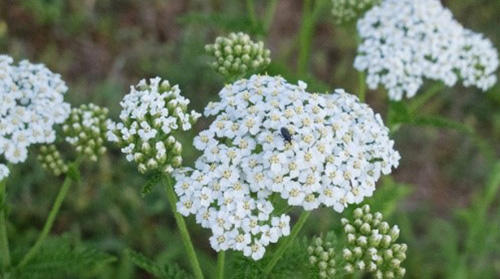
Yarrow – (Achillea millefolium) You may have this in your yard and you may think it’s a weed. It’s actually an herb. It can be used for a number of things such as reducing fever in tea form; topically for rashes and itching, and when combine with plantain helps stop bleeding and avoid infections; in tincture form it can help with menstrual cramps and hormone issues. It can also be added to lotions and salves to help with eczema.
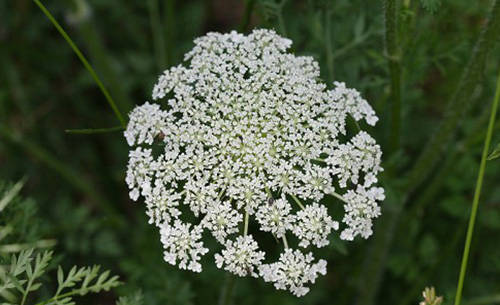 Queen Anne’s Lace – (Daucus carota) Also known as wild carrot, this little plant has a host of vitamins not the least of which are B and C. It contains flavonoids and essential oils. In tea form, it has been used to prevent and eliminate kidney stones. It is used by some women as a contraceptive. The most used application forms are tea or tincture.
Queen Anne’s Lace – (Daucus carota) Also known as wild carrot, this little plant has a host of vitamins not the least of which are B and C. It contains flavonoids and essential oils. In tea form, it has been used to prevent and eliminate kidney stones. It is used by some women as a contraceptive. The most used application forms are tea or tincture.
How to tell the difference: The flowers are similar, but the yarrow flowers are more clustered as opposed to the umbel of the Queen Anne. The leaves of the yarrow are alternate, while the leaves of Queen Anne’s lace are opposite. The leaves of the yarrow are also more finely divided.
These are just a few examples of plants you may have in your own yard. Amazing, isn’t it? It certainly has made me look at the plants outside my door in a whole new light. To know that I can walk out my door and pick leaves off of one plant to draw the itch out of a bug bite or could quickly pluck a leaf from another plant that would stop a cut from bleeding is empowering. You could even consider cultivating those plants you once considered a nuisance into an area of your yard specifically for that purpose so that you can bypass them with the lawn mower and weed eater.
So, before you drag out the weed killer take a good look at what’s growing there. It might be something you can use to treat yourself or your family. In an emergency situation, it might be the only thing you have. Make sure you know the plant and its use, as well as the proper application of the plant parts. There are many great books available on plant identification and uses, including recipes on how to make tinctures and tonics. I highly recommend buying a few to have on hand.
This post is not meant to steer you away from the prescription drugs you may currently be taking. Always check with your doctor or pharmacist for possible adverse reactions or interactions with your current medications. It is meant to educate you on natural alternatives that are available, so you can make informed decisions about the health and wellbeing of you and your loved ones.
Click below to find out how you can turn common weeds around your house into powerful remedies.

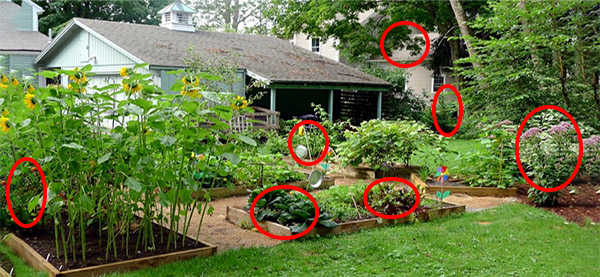
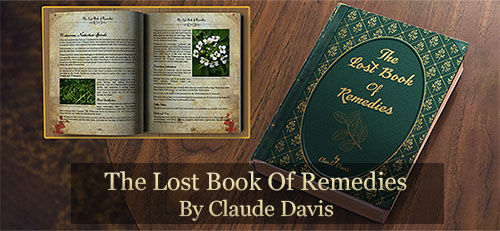













Great article – it’s amazing what we don’t know!
There are so many different plants that are beneficial, my main concern are the look a likes, such as the elderberry and the devils walking stick, this was a limited but good article as it informed us that the berries of the walking stick are toxic, that is something I would like to see more of, ie:any part of the Mullien toxic or the lambs ear,many people dont know about the universal edibility test ( I dont think thats the correct name) and many dont have the required 24-36 hours to perform that test.. still all in all a very informative article
Thank you
Lookalikes are my problem too. I’ve found that most books about plants don’t make it any easier to tell the difference either.
It takes four days. You crush a piece of the plant and rub it on the skin inside your elbow. Wait 24 hours. If no reaction, repeat the procedure on your lip. Wait 24 hours. If no reaction, chew a piece of the plant but don’t swallow. Wait 24 hours. If no reaction, chew a small piece and swallow. Wait 24 hours. If no reaction, the plant is safe to eat.
Not recommended if you are already out of food. Like all preparation, better to do ahead of time than wait until it become urgent.
There are many plant lookalikes in nature with extreme differences in human reaction unless you are really familiar with the subtle variations, better to err on the side of safety.
Different parts (flowers, leaves, stem, bark, roots) should be considered in the test as on some plants, only certain parts are edible.
I tasted a devils walking stick berry, it tasted good and sweet. I had been told it was elder berry. I didn’t trust the source so I spit it out and washed out my mouth. The plant did have a few very scattered thornes.
Becareful that you don’t confuse them with water hemlock..
WIld carrot has a distinct carrot scent.
There are currently 3 roots that can be readily identified via smell. Just scrape a little area until it’s moist and smell.
** Note: When testing, make sure to wash your hands or implements thoroughly between attempts. If you have something inedible (and possibly poisonous), you don’t want to accidentally ingest it.
1) Queens Anne Lace (aka. Wild Carrot)
2) Wild Garlic (aka. Wild Onion)
3) Galic [Cultivated and or Wild Varieties]
If it smells like a carrot, onion, or a garlic – it is.
Go ahead, check my research, please.
Were can we buy this book??
Also have to be careful not to confuse Queen Anne’s Lace with Giant Hog plant. The results could be fatal. Giant Hog plant is a recent border crosser and causes a huge sensitivity reaction like the worst case of poison ivy/oak you ever saw. Leaves permanent scars and a hypersensitivity to sunlight. It can be fatal given a large enough area of reaction.
I also read recently that hemlock can be confused with Queen Anne’s Lace, and can cause serious skin irritation, as well as death if ingested. This is becoming a problem in south central PA.
While there is some similarity in growth form, I do not see that hemlock could be regularly cofused with wild carrot(=Queen Anne’s Lace.) Hemlock leaves are not near as lacy, are much bigger, and the plant grows mostly in wet, low lying areas. QAL grows on dry ground, is shorter, and crushed leaves smell like carrots.
I live in Iowa. I had a poison hemlock (the plant used to execute Socrates) pop up in my front yard next to the front porch. I didn’t know what it was at first. I thought it was a beautiful plant. The leaves were so feathery looking and the flowers were attractive. I thought it might be Queen Anne’s Lace so I looked it up on the Internet. That’s where I got my first warning that it might be a dangerous look-alike. I read all the information about how to tell them apart and came to the conclusion that it was hemlock. I left it there till the end of the growing season and then cut it out, bagged it, and took it to the city landfill. I got further confirmation of its identity when I cut it down because the center of the stalk was hollow-a characteristic of hemlock.
I wouldn’t suggest a novice foraging Queen Anne’s lace unless you have purposely planted it in your yard. It looks very similar to poisonous hemlocks as they are in the same family.
I liked the idea of planting some of the weeds to see what they looked to help identify each one correctly in the wild. But, I’m not sure where to go to buy the seeds. Vegetable seeds are easy to find. I didnt expect the results I got from Googling “various weed seeds”!
Hi Brett, There is a Seed Booklet called Strictly Medicinal where you can find almost any of these seeds and plants, the book can be had by getting in contact with
strictlymedicinal.com.
Good luck, Dave!!
Get error message – can’t provide a secure connection!
Try strictlymedicinalseeds.com. You can request a catalog. They sell both seeds and live plants!
A little more about giant hogweed:
Giant Hogweed (Heracleum mantegazzianum)
The toxic plant grows in New York, Pennsylvania, Ohio, Maryland, Oregon, Washington, Michigan, Virginia, Vermont, New Hampshire, Indiana and Maine. If it is in Oregon it probably is in the northern reaches of the PDRK.
In the picture, which somehow I cannot copy, it looks just like Queen Anne’s lace. Guess that means I shouldn’t start on my botany PhD thesis this weekend. Although I did take a course called “Medicinal Plants of the Southern California Coastal Region” last summer. And I did learn something. Buckwheat is very common in the PDRK and large fields of it which I did not know was buckwheat I now can recognize. However you do need a really large field of it to put away any quantity of the grain.
Also, apparently all grass seeds are edible. The guy on the corner is growing a large plot of seeded grasses, so if the EOTW happens this week, I know where I am going to start harvesting. He also has a nice crop of just plain old hog weed which sort of looks like dandelion and the young leaves of which are edible. The root can be made into a tea like dandelion. Speaking of which, a grocery chain that I shop at has a large selection of herbal teas. I saw dandelion tea on display there and got a box to try. I think they need to wash the dandelion roots before they grind them up to make the tea. It had a distinctive earthy aftertaste.
For now I am sticking to Lipton’s orange pekoe. When I run out then I will start harvesting dandelion root.
Lipton’s? Please do yourself a favor and spring the few extra pennies to get a real tea, like Red Rose or Twining’s. When you taste the difference you’ll be glad you did.
What’s wrong with Lipton’s? A lot of us grew up drink it. As far as black teas go, I prefer Lipton’s for cold tea but not hot, whereas Twining’s has probably the best blends for hot tea.
Lipton’s over dandelion root for sure. It may not be premium tea, but given a choice, dandelion root is just a bit too earthy for my tastes, thank you. I’m just not hungry enough yet.
I’ve never tried Twining’s. I will pick up a box the next time I am in the grocery store and give it a try.
I’ve never tried dandelion root tea. I take the root in capsules to help with various ailments. I bet it is very earthy by itself.
As for the Twining’s, I prefer either the Irish or English Breakfast Teas. The Irish blend is the stronger of the two. Bigalow makes an American Breakfast Tea. You really have to be careful when brewing it since it contains 50% more caffeine than other breakfast teas. I felt like I was running a marathon after drinking a mug of it. I learned the hard way that I could not brew it as strong as I like my morning tea.
Hello LCC, Republic of Tea has a great selection of teas. I have had their dandelion tea with a little vanilla. It tastes great!
Queen Anne’s lace is also known as wild carrot, the way you can tell is by digging up the root and it smells like a carrot or break the stalk off above ground, which also smells like a carrot
Be careful of the Elderberry also, the berries are edible but the berry stems are toxic
Actually according to the instructor of the course I took last summer, the seeds contain cyanide but in such small quantities that if you manage to swallow a couple, you won’t suddenly topple over. He did recommend not making it a habit of eating too many. He also recommended avoiding chewing the seeds. He suggested the way to eat elderberries was to just mash the meat and then spit the seeds out after cleaning off the meat of the fruit.
I have embraced what is in my yard. About 5 years ago, a strong smelling ‘weed’ began growing. It has taken to our property and it is great. Herb Robert Geranium! It’s great for fleas, masquitoes, and even spiders. That doesn’t include the benefits of teas, etc… I do have to thin it out, but it’s great stuff. I just learned more about tea made from the leaves from our walnut tree. So amazing. The Purple dead nettle, nipplewort , and many other things that are consider weeds have so many great medicinal and food value. I am loving it. Your article just reminds me of what is available if you just look!
Another way to tell Queen Annes Lace is to look a the flower head. In the center if it has a single red colored floret, ( again you have to look very close) it is Queen Annes Lace. As a disclaimer please confirm.
Unless I need to get stitched up or have a bone set I don’t have anything to do with AMA type medicine, my primary care physician is an Osteopath who got a degree in Traditional Chinese Medicine, she studied over the decades with a master Acupuncturist and Herbalist. The Chinese herbal tradition is really strange, it is based on regulating body heat. I had TBI years ago that included damage to whatever up there regulates body temperature, when it gets really out of whack she brings it under control with Acupuncture. But Chinese herbs do not agree with me.Every culture has it’s herbal tradition, the one I find relevant is Native American Southwest because that’s the part of the world I love. The thing about herbal medicine is its relationship to subsistence culture, survival is all about privation, hardship, even starvation, and the broadest usefulness of herbaceous plants is in providing vitamins and vital nutrients after a tough winter of spoiled bacon and moldy bread.
I take 2 herbs regularly, standardized Echinacae 2 capsules a week to prevent cold and flu, and 2 shots of cheap Tequila which cures everything else.
The best way to learn about plants is to buy a beginner level guide that uses photos to identify plants in your area. Learn 25 plants that way, with that simple foundation you can start the Key and Guide process where you learn to I.D. plants by leaf characteristics, then flower parts. Then you can learn about the birds and bugs and stuff and one day if you are in the woods and truly hungry you’ll know where to find the thumb size grubs of the Rhinoceros beetle, get some hot coals going, find a flat stone to use as a Comal and fry those critters to a crisp golden brown…
I am 76 years young, living in Florida trying to grow a garden in sand. Years ago when I was younger and a foolish know it all, I was pulling “weeds” from my garden in Wyomings’ rich ground. A neighbor came over and asked me if I knew what that plant was and what it did? I said “no sir, but it is a pest and I am going to pull it.” Now in my more mature years, I wish many times that I had listened to that old man, I would be much smarter. I am proof that you just can’t teach youngsters things that are good for them.
In 1974 a lady gave me the book “Back to Eden” by Jethro Kloss when I re-married. It has proven insightful and an excellent source of herbology. You can still get it today. I practiced learning as much as I could. Now I am going back to this same book to re-learn what I have forgotten. I also bought the first “The Lost Ways” which have approx. 24 standard herbs. The book has great information in general. Will try to get the Lost Ways book 2! Thank you Claude!!
LMAO, all kids are that way. I sure was. My kids are too, and will continue to be until one day they AWAKE THE HELL UP and figure out that life is not all a bowl of cherries or that everything is not just thrown out when it doesn’t work. It’s called: Learning, 😉
Just an FYI:
Giant Hog Weed is indeed a plant to avoid coming in contact with above all others.
I believe it would however be difficult to confuse with QueanAnns Lace. G H W grows to 15′. It’s leaves are not lacy and are very large. I believe even in it’s infancy it’s leaves could never be confused with wild carrot.
Many plants may have a different appearance even in the same area. Leaves can be broad or narrow (lance shaped). Flowers may be compact or sparse. All this on the very same plant. I don’t know if it’s in the genes or the soil, but it can make it very difficult at times to positively identify a plant.
But getting back to Giant Hog Weed, key in on the word Giant. Even when it’s just getting started it will have leaves much larger than wild carrot (Queen Ann’s Lace) will ever grow & they are not “fern like” but LARGE deeply lobed leaves.
Is there anything on this site that is really worth reading? Take for example this page, the first 6 links on the left side are JUNK VIDEOS WITH NOTHING MORE GOING ON THAN TO TAKE YOUR MONEY!! And even this **article** is basically worthless since it only addresses 5 or six plants.
Is this just a site for advertisers or what??????!!!!!!!
I guess it depends upon how much you think you know. As I indicated in my post above, I am a real babe in the woods when it comes to identifying wild plants. Too many of them look alike. I try to read all I can about wild plants and their uses, so while this article only described 5 or 6 plants, it added to my store of knowledge. Also, the responses of the followers of this list frequently augment the main article and add to the knowledge base. There sure is a lot I don’t know about a lot of things and while some of the articles are misses, There are darned few article where I don’t learn something either from the article or the posts that accompany it.
Of course, if you have already gleaned all the knowledge you feel you need to survive in an unknown world, then, yes, this site is a waste of time.
I personally couldn’t tell you what ads are on the page as I never look at them. I am sure the owner of this site will be disappointed to hear that but then life is full of disappointments.
Each of us must decide where we will gain our knowledge of topics on survival and when we read such advice, each of us must decide for ourselves just how much credence we will place in that advice. If you are unhappy with the information, certainly there is nothing to make you continue to waste your time perusing the site.
Personally, I find this site one of the more informative preppier sites and read it regularly.